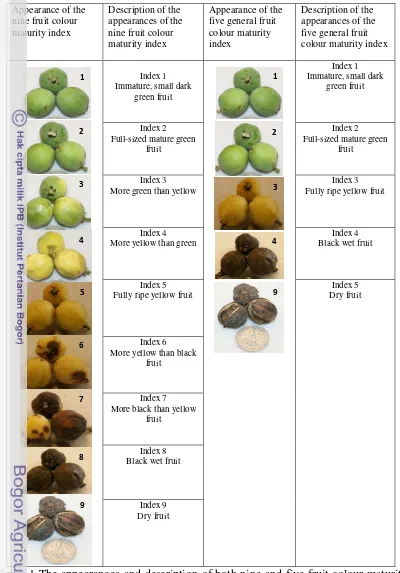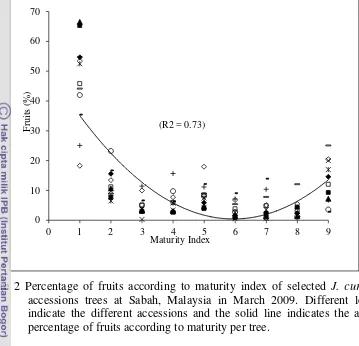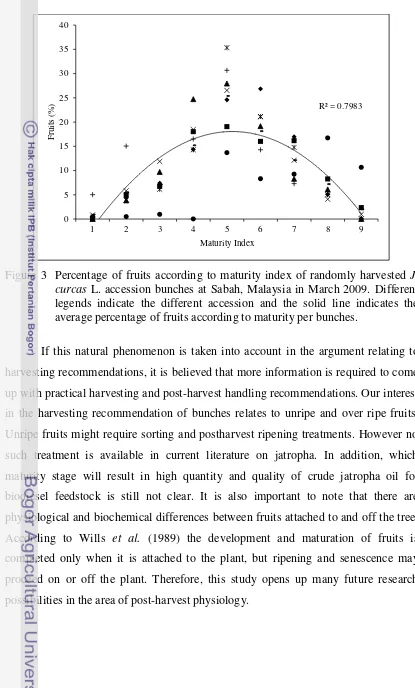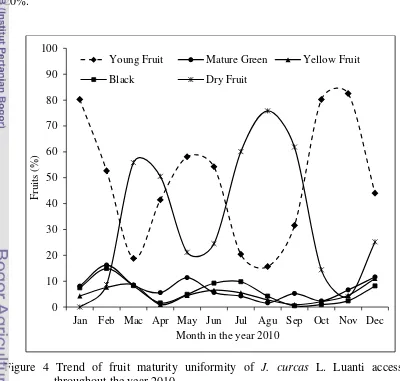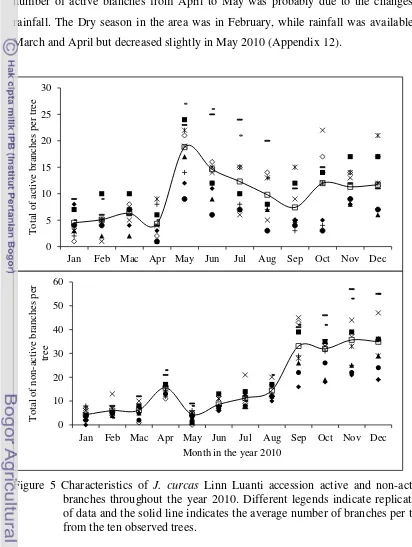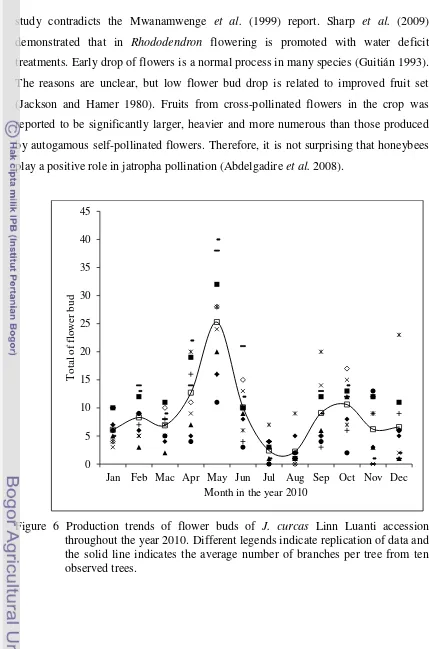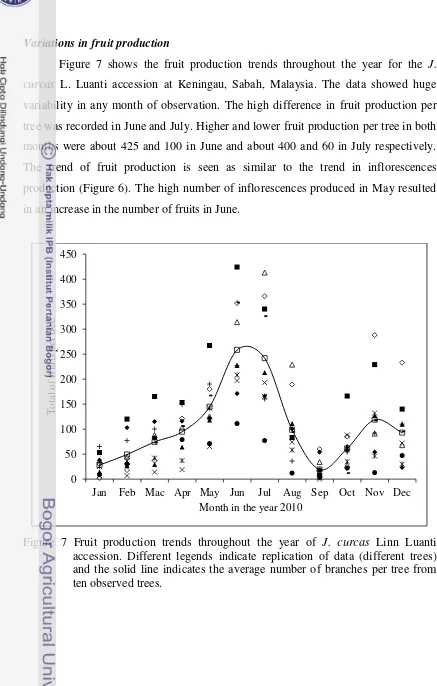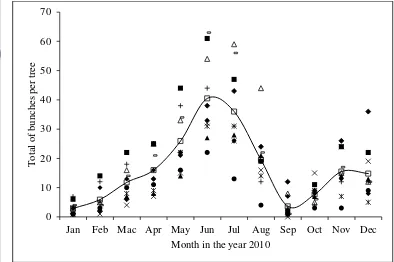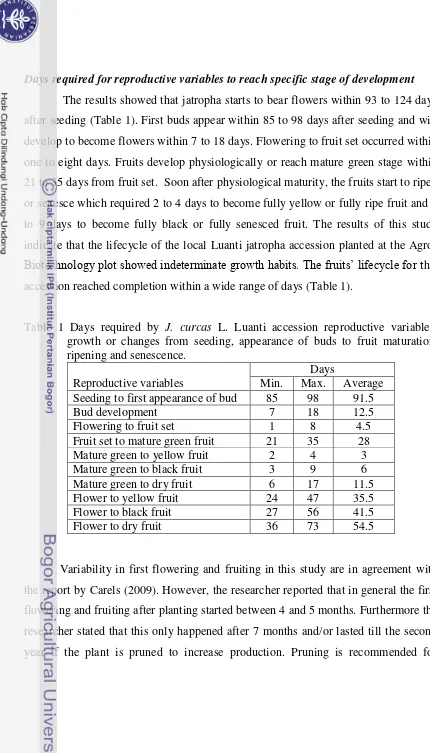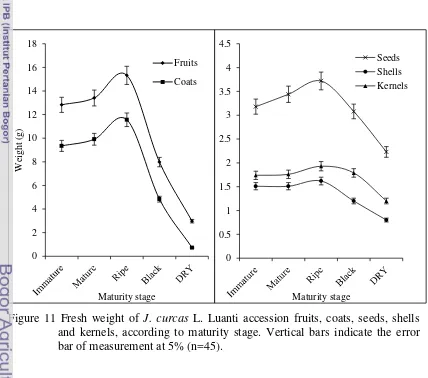AND EXTRACTABLE OIL YIELD OF JATROPHA
(
Jatropha curcas
Linn
)
JUPIKELY JAMES SILIP
THE GRADUATE SCHOOL
BOGOR AGRICULTURAL UNIVERSITY
BOGOR
Hereby, I state that the dissertation entitled “Fruit Maturity Uniformity and Extractable Oil Yield of Jatropha (Jatropha curcas Linn)” Is my own work, which has never previously been published in any university. All of incorporated originated from other published as well as unpublished papers are stated clearly in the text as well as in the references.
Bogor, June 2011
Jatropha (Jatropha curcas Linn). Advised by ARMANSYAH H. TAMBUNAN (as chairman), ERLIZA HAMBALI, SUTRISNO and MEMEN SURAHMAN (as members).
The primary objective of this study was to determine the physiological occurrences during the life of the fruit on and off the jatropha tree. The work began with determining the reproductive characteristics followed by determining
the fruits’ physicochemical characteristics during maturation, ripening and senescence on the tree. The effort was continued with determining the effect of selected postharvest handling practices on increase oil extraction yield, followed by determination of harvesting indicators and finally a study on ripening treatments for harvested mature green jatropha fruits. The study on reproductive characteristics showed wide variation among observed variables during the months of observation. The crop showed indeterminate reproductive characteristics and therefore it was expected that it would be difficult to schedule harvesting which could lead to high harvesting costs being incurred. To reduce the expected harvesting problems required, understanding the harvest characters and therefore monitoring changes in selected physicochemical characteristics during the life of jatropha fruit was performed. The extracted oil yield was significantly high from dry fresh fruit kernels. However, the extracted oil was not only different according to maturity stage but also affected by postharvest handling practices such as drying prior to extraction. Extracted oil from off-tree ripened fruits was significantly higher compared to the on-tree ripened fruit. The advantage of high oil accumulated in the kernels of off-tree ripened fruits was
solely dependent on the harvester’s capabilities to determine the individual
physiological mature fruits in the farm. However, this study recommended harvesting bunches instead of individual fruits for increased advantage in harvesting volume. The fruit bunch harvesting indicator was bunches with maximum 80% of fruits still green in color and others advanced in maturity as either yellow ripe or senescent fruits. The physiologically mature green fruits were subjected to various ripening enhancers. Treatment with calcium carbide showed that a minimum of three hours exposure to ripen and senescence was better. Field heat as a ripening enhancer also showed good potential. This study demonstrated that poor harvesting is not the major reason for not commercializing this non-edible biodiesel feedstock.
JUPIKELY JAMES SILIP. Fruit Maturity Uniformity and Extractable Oil Yield of Jatropha (Jatropha curcas Linn). This study was advised by
ARMANSYAH H. TAMBUNAN (as chairman), ERLIZA HAMBALI, SUTRISNO and MEMEN SURAHMAN (as members).
Poor harvesting has been the major limiting factor for commercialization of this crop, which has been highlighted in various publications (ERIA 2010, Biswas et al. 2006 and Heller 1996). Jatropha fruits mature heterogeneously which leads to laborious and time consuming harvesting because the harvesters have to select only the fruits that are of the right ripening index for processing. Further the fruits have to be harvested manually at regular intervals. Sivapragasam and Puteh (2008) reported that the amount of harvested jatropha fruits was only about 100 g.minute-1 or about 6 kg.hr-1. Furthermore, they concluded that 80% of seeds production costs was mainly on harvesting and postharvest handling. Mechanical harvesting of this crop was considered impossible due to its indeterminate flowering and growth habit. Today, jatropha fruits are still harvested by hand in small and plantation scale farms. Jatropha seeds in
Myanmar’s eight million acres were reported to be rotting on the farm due to poor
harvesting technology (Jim 2009). The indeterminate reproductive habit of this crop is thought to be responsible for this problem, but little information exists on these characteristics.
The primary objective of this study was to determine the physiological occurrences during the life of the fruit on and off the jatropha tree. The work began with determining the reproductive characteristics followed by determining
the fruits’ physicochemical characteristics during maturation, ripening and
senescence on the tree. The effort was continued with determining the effect of selected postharvest handling practices on increase oil extraction yield, followed by determination of harvesting indicators and finally a study on ripening treatments for harvested mature green jatropha fruits.
physical variable data indicate benefits in removing the fruit coat prior to further handling practices such as transportation and storage because fruit coats implied increased weight and surface area. Trade of jatropha is suggested to be best with fresh fruits because maturity of harvested fruit can be judged with the naked eye. Recommended harvest index for jatropha is dry harvested fresh fruit because it has high chemically extracted oil yield. However, the recommendation requires future study because the efficiency of oil extraction yield was affected by several factors. The relationship between extracted oil yield and water content revealed the function of moisture content. Changes in the kernels’ soluble solid concentration during the life of the fruit indicated low oil synthesis during the ripe stage but increased during senescence. The pH value of kernels at any maturity stage was between pH six and seven indicating the presence of low ionic value in the sample. Percentage of free fatty acids at any maturity stage in this study was below two percent which indicates the benefit of only requiring esterification during biodiesel processing. Respiratory study indicated jatropha fruits as climacteric fruits with up surge in production of carbon dioxide during off-tree fruit ripening. This study suggests future studies on the effect of several handling practices such as the effect of drying prior to oil extraction and extracted oil yield from off-tree ripe and senesced fruits. The handling practices may influence the oil extraction yield.
off-tree ripened fruit compared with the on-tree ripened sample. The new finding implies requires further investigation. The success of this new finding depends on the success in harvesting physiologically mature green fruits.
The study has identified individual and fruit bunch harvesting indicators for jatropha. Individual fruit character of mature green with trace of yellow was recommended as the individual harvesting indicator. Fruit bunch harvesting indicator was those bunches that has maximum 80% of fruits that were still green in color while the others were advancing in maturity as either yellow ripe or senescent. The trend of harvestable fruit production throughout the year confirms three big harvesting times in a year. Those are in in March, August and December. However, the data on fall fruit during delay in harvesting suggests that the harvesting times should be repeated within 6 and 17 days to avoid fall fruits. Increase in fall fruits percentage was a function of time and was best described as a logarithmic trend (R2=0.94). The fall trend showed a plateau after about two months of observation indicating occurrences of multiple dry fruit bunches in the same branch. The occurrence was easily observed during the dry season. The extracted oil yield from up to five different levels of dry fruit bunches from the same branch was found to be almost uniform at about 55% except for the samples from the second from bottom of the branch which has about 60% yield. However, the extracted oil yield from fall fruits was found to be significantly low at only about 40%. The disadvantage of fall fruit in this study suggests that the harvesting visits could be prolonged if 100% mature green fruits can ripen off the tree. Thus, the potential of several ripening enhancers to the harvested mature green jatropha fruits was also tested in this study.
This study demonstrates the effectiveness of CaC2 and direct sunlight
exposure as ripening enhancers for harvested mature green fruits. Treatment with any of the enhancers will hasten ripening and senescence. Minimum three hours but not more than six hours exposure to CaC2 is recommended to get best ripening
JUPIKELY JAMES SILIP. Keseragaman Matang Buah dan Hasil Ekstrasi Minyak Jarak Pagar (Jatropha curcas Linn). Dibawah bimbingan
ARMANSYAH H. TAMBUNAN (ketua), ERLIZA HAMBALI, SUTRISNO dan MEMEN SURAHMAN (ahli).
Panen yang buruk telah menjadi faktor utama terbatasnya komersialisasi tanaman ini, dan hal ini telah dikemukakan dalam berbagai publikasi (ERIA 2010, Biswas et al. 2006 dan. Heller 1996). Buah jatropha yang matang secara heterogen menjadi suatu pekerjaan yang melelahkan dan memakan waktu karena pemanen buah jatropha harus memilih hanya buah-buahan yang telah matang dan tepat untuk diproses. Selanjutnya buah tersebut harus dipanen secara manual pada periode tertentu. Sivapragasam dan Puteh (2008) melaporkan bahwa jumlah buah jarak pagar yang dipanen hanya sekitar 100 g.minute-1 atau sekitar 6-kg.hr 1. Selanjutnya, mereka menyimpulkan bahwa 80% (delapan puluh persen) dari pengeluaran biaya untuk produksi bibit adalah untuk panen dan penanganan pascapanen. Teknik pemanenan secara mekanis untuk jenis tanaman ini tidak dimungkinkan karena sifat tanaman yang tidak teratur cara berbunga serta pertumbuhannya. Sampai sekarang, buah jatropha hasil perkebunan skala kecil maupun besar masih dipanen dengan tangan. Biji buah jatropha hasil tanaman yang ada perkebunan seluas 8.000.000 ha. (delapan juta hektar) di Myanmar dilaporkan membusuk karena teknologi panen yang buruk (Jim 2009). Kebiasaan reproduksi yang tidak menentu tanaman ini dianggap sebagai penyebab masalah ini, tetapi informasi tentang hal tersebut yang tersedia sedikit sekali.
yang berwarna kuning atau ketika tandan berusia 45 hari setelah bunga mekar. Santoso (2008) juga menyatakan adanya kesamaan dengan laporan Wanita dan Hartono tentang kandungan minyak kernel. Inkonsistensi dalam rekomendasi menunjukkan pentingnya diadaknnya penelitian lanjutan untuk masalah ini.
Tujuan utama dari penelitian ini adalah untuk menentukan fisiologis buah yang masih segar di pohon maupun yang sudah dipanen. Penelitian diawali dengan menentukan karakteristik reproduksi, kemudian menentukan karakteristik fisikokimia buah selama proses tua dan pematangan di pohon. Kemudian dilanjutkan dengan menentukan pengaruh penanganan pascapanen untuk meningkatkan minyak hasil ekstraksi, selanjutnya penentuan indikator panen, dan akhirnya pengkajian tentang penanganan buah jatropha hijau yang matang.
reproduksi tidak terbatas (indeterminate). Sebagai tanaman dengan tipe ini, perlu diadakan kajian lebih lanjut untuk mendapatkan variabel penting sebagai solusi masalah pemanenan.
harapan karena minyak jarak mentah komersial diproduksi dengan menggunakan metode ini. Hal ini menunjukkan efek positif pengeringan sampel untuk meningkatkan hasil ekstraksi minyak. Untuk meningkatkan efisiensi ekstraksi dengan penjepit (presser) hidrolik yang dimodifikasi, cara penanganan spesifik direkomendasikan. Sebelum ekstraksi, sampel harus dihancurkan karena kernel lumat menghasilkan minyak ekstraksi yang lebih tinggi dibandingkan dengan sampel yang tidak dilumatkan atau yang masih segar. Temperatur yang dinaikkan, waktu pemanasan dan penekanan yang terbaik pada suhu 50oC, dengan durasi penekanan selama 10 menit atau lebih lama. Secara signifikan, hasil minyak yang diekstrak secara kimiawi dari buah matang yang diperam lebih tinggi dibandingkan dengan buah yang matang di pohon. Hasil temuan ini memerlukan penelitian lebih lanjut. Keberhasilan temuan baru ini tergantung pada panen buah hijau yang matang secara fisiologis. Indikator panen akan dibahas dari hasil test berikutnya.
diekstraksi dari buah yang gugur secara signifikan menunjukkan 40% (empat puluh persen) lebih rendah. Kerugian dari buah yang gugur dalam penelitian ini merekomnedasikan untuk memperpanjang masa pemanenan agar 100% (seratus persen) buah yang tua diperam supaya masak. Dengan demikian, berikut dalam disertasi ini akan membahas potensi percepatan pemasakan buah jatropa hijau yang sudah tua yang dipanen.
Hasil penelitian ini menunjukkan adanya efektivitas CaC2 dan ekspos
dibawah sinar matahari langsung buah jarak hijau matang yang dipanen sebagai percepatan pematangan. Penanganan dengan salah satu bahan percepatan pematangan dan penuaan. Untuk mendapatkan hasil pemeraman yang baik serta menghindari gangguan dalam proses pematangan dianjurkan agar buah jarak diperam dengan menggunakan CaC2 minimum tiga jam dan maksimum enam
© Copyright 2011 by IPB
All rights reserved
1. No part or all of this dissertation may be excerpted without or mentioning the sources a. Excerption only for research and education use, writing for scientific papers,
reporting, critical writing or reviewing of a problem.
b. Excerption doesn’t inflict a financial loss in the paper interest of IPB.
JUPIKELY JAMES SILIP
A Dissertation
Submitted in partial fulfillment of the requirements for the
Degree of Doctor in Agricultural Engineering Science
THE GRADUATE SCHOOL
BOGOR AGRICULTURAL UNIVERSITY
BOGOR
Examiners for Close Exam : Dr. Ir. Endah Retno Palupi, M.Sc : Dr. Ir. Dyah Wulandani, MSi Examiners for Open Exam : Dr. Bambang Prastowo
Approv ed by,
Advisory Committee
Prof. Dr. Ir. Armansyah H. Tambunan Prof. Dr. Erliza Hambali
Chairman Member
Dr. Ir. Memen Surahman, MSc.Agr. Dr. Ir. Sutrisno, M.Agr Member Member
Acknowledged by,
Head of Study Program in Dean of the Graduate School Agricultural Engineering Science
Dr. Ir. Wawan Hermawan, MS Dr. Ir. Dahrul Syah, Msc.Agr
Date of Examination: Date of Graduation:
Jatropha (Jatropha curcas Linn)
Name : Jupikely James Silip
Praise God the Almighty for the overall conducive conditions for me to pursue my PhD studies and His blessings to successfully complete it.
My sincere gratitude is extended to the Ministry of Higher Education Malaysia for the SLAI scholarship awarded as well as the Research Collaboration with the Agro-Biotechnology Institute, Malaysia with recommendations from the Ministry of Science, Technology and Innovation Malaysia, YB Datuk Seri Dr. Maximus Johnity Ongkili, to the former Universiti Malaysia Sabah
Vice-Chancellor Prof. Dato’ Dr. Mohd Noh Bin Dalimin for introducing me with Bogor
Agricultural University and to the present Univeriti Malaysia Sabah Vice-Chancellor Brig. Jen. Prof. Datuk Seri Panglima Dr. Kamarulzaman Hj. Ampon for approving my study leave and all the encouragement.
The words “Thank You” is not sufficient to express my appreciation to my
supervisors: Prof. Dr. Ir. Armansyah H Tambunan for his guidance, patience and sacrifices, Prof. Dr. Erliza Hambali for sharing her special and inspirational thoughts, Dr. Ir. Sutrisno and Dr. Ir. Memen Surahman for their critical and constructive comments on this study.
Dr. Ir. Rokhaini Hasbullah, my internal PhD pre-qualifying examiner, my closed exam examiners Dr. Ir. Endah Petro Palupi and Dr. Ir. DyahWulandani, my open exam examiners Dr. Bambang Prastowo and Dr. Y. Aris Purwanto your critical questions have helped me improve and make my work more in depth.
remembrance: Prof. Dr. Ridzwan A. Rahman, Prof. Madya Dr. Mahmud Sudin, Prof. Madya Dr. Markus Atong, Prof. Madya Dr.Siti Hajar Ahmad, Dr. Chong Khim Phin, Mr. Bonaventure Boniface, family of Wattimena (Prof. G. A. Wattimena, Prof. Fred Rumawas, Pak. Martin, Pak. Agus, Pak. Alex, Sri Lucy Mathilda, Ibu Paulin, Pak Luki dan Bung Peter), Mr. Awang Rahim, Pak Darman, Pak Firman, Pak Mule Ahmad Mulyawatullah, En. Ahmad Manik, Pn. Kristina Kungin, Ibu Ucher, En. Airin, En. Asrizal, En. Josper Resiun, En. Jabi,
En.Makunsai and all the laboratory assistants at Universiti Malaysia Sabah’s
School of International Tropical Forestry, and the School of Food Science and Nutrition.
Those friends that I made throughout my studies, Dr. Ir. Lamhot Manalu, Dr. Ir. Soni Solistia Wirawan, Dr. Ir. Rizal Alamsyah, Dr. Ir. Bambang Santoso, Ir. Tuti Sri Mudiastuti, Ir. Solehudin, Ir. Bayu, Ir. Yaoi Hidetoshi, Ir. Amar
Ma’ruf, Ir. Zainal Hassan, Dr. Robert, Dr. Abin, Dr. Laurance, Dr. James Alin, Dr. Anthony Tibok and Mr. Yap Yun Fook, Mr. Michael Gudipo, Mr. Ben Golimbi, Mr. Frankie who had all lent a hand when it was most needed, and shared their valuable ideas and insights in relation to this study.
Last but not least, I want to express my deepest appreciation to my family, especially my dearest mother, Mrs. Lasanim @ Bidah Parantis Sobutil and my father Mr. Silip @ Philip Baniat Kombotik who have always been there for me and always prayed for me and gave me moral support to complete my studies. I would just like to express my love to them all including my brothers Casmir, Ronmandus, Benjamin, Christopher, and my sisters Selvia and Antonia.
Above all, I am grateful to my wife Mrs. Rosnie Phelemon Sagedon for always being passionate, supportive, positive and encouraging. I dedicate this work to my children Cyde, Cylistah, Cyleen and Cydell. I wish that this work will be of benefit to readers and contribute to the development of knowledge.
Jupikely James Silip (author) was born on May 4 , 1975 at Luanti Baru Village in the District of Keningau, Sabah, Malaysia. He is the third son of Mr. Silip Philip Baniat and Mrs. Lasanim Bida Parantis. The author completed his primary school education at SK Sodomon, Keningau in 1987 and secondary school at SM Bingkor, Keningau in 1992. He completed three years of general agricultural courses in 1996 where he was the top student and best academic achiever at Institut Pertanian Sabah, Timbang Menggaris. He also served as Farm Manager for 14 months at Livestock Evergreen Sdn. Bhd. before continuing his studies pursuing a Diploma in Animal Health and Production at Faculty of Veterinary Sciences, Universiti Pertanian Malaysia, which he completed in 1999. He completed his first degree of Bachelor of Bio-industry Science at the Faculty of Agriculture at the same University in 2001. He received a PASCA scholarship to continue his studies and completed his Master in Agriculture Science at the same Faculty in 2003. In September 2008, the author registered as a PhD student in the Agriculture Engineering Program at the School of Postgraduate, Bogor Agricultural University which he completed in June 2011.
TABLES OF CONTENTS
Physicochemical Changes during the Life of Jatropha Fruits …….Crude Jatropha Oil ………...
Harvesting System of Jatropha Fruit ………
Artificial Ripening ………...
Control of Fruits Maturation, Ripening and Senescence ………….
3 GENERAL MATERIALS AND METHODS ………
Source of Samples ………...
6 STUDY ON THE EFFECT OF SELECTED POSTHARVEST
7 STUDY ON HARVESTING CONSIDERATION FOR
JATROPHA FRUITS ………..………….
Introduction ……….………....
Materials and Methods ………
Results and Discussion ……….
Conclusion ………
8 STUDY ON ENHANCING FRUITS RIPENING OF HARVESTED
LISTS OF TABLES
Pages 1 Days required by J. curcas Linn Luanti accession reproductive
variables: growth or changes from seeding, appearance of buds to fruit maturation, ripening and senescence. …..….………
2 Size (length and girth) characteristics of J. curcas Linn Luanti accession fruit and seed according to maturity stage (YF: young fruit, MG: Matured Green, MGY: more green than yellow, MYG: more yellow than green, Y: yellow, MYB: more yellow than black, MBY: more black than yellow, Black: black fruit and Dry: Dry fruit) (n=45).
3 Jatropha fruit coat, shell and kernel color (L*, C* and ho value) according to pre-determined maturity stages. YF (immature young green fruits), MG (mature green), MGY (more green than yellow), MYG (more yellow than green), Y (ripe yellow fruits), MYB (more yellow than black) and MBY (more black than yellow). ………..
4 Firmness (N) of fresh J. curcas Linn Luanti accession fruit coat, shell and kernel according to maturity stage. ……..………...
5 Changes in the percentage of unripe, ripe and senescent fruits between harvested immature, mature green and mature green with trace of yellow J. curcas Linn Luanti accession fruits during storage..
6 A change in percentage of ripe, unripe and senescent fruits from harvested five different fruit bunch characters during storage. …...
7 Effect of exposure duration (h) with calcium carbide on ripening uniformity of harvested mature green jatropha fruits ………….……...
76
83
86
88
119
121
8 Effect of harvesting at different times of day on ripening uniformity of harvested mature green jatropha fruits. …………...
9 Effect of packaging conditions on ripening uniformity of harvested mature green jatropha fruits. ……..………
10 Effect of sunlight exposure duration on ripening uniformity of harvested mature green jatropha fruits. ………...
11 Effect of packaging conditions and harvesting time on germination percentage of off-tree senescence of harvested mature green jatropha
fruits. ………..
137
139
141
LISTS OF FIGURES
Page 1 The appearances and description of both nine and five fruit colour
maturity indexes for measurement of J. curcas Linn fruit maturity
uniformity. ……….
2 Percentage of fruits according to maturity index of selected J. curcas L. accessions trees at Sabah, Malaysia in March 2009. Different legends indicate the different accessions and the solid line indicates the average percentage of fruits according to maturity per tree. ……...
3 Percentage of fruits according to maturity index of randomly harvested J. curcas L. accession bunches at Sabah, Malaysia in March 2009. Different legends indicate the different accession and the solid line indicates the average percentage of fruits according to maturity
per bunches. .………..
4 Trend of fruit maturity uniformity of J. curcas Linn Luanti accession
throughout the year 2010. ……….……….
5 Characteristics of J. curcas Linn Luanti accession active and non-active branches throughout the year 2010. Different legends indicate replication of data and the solid line indicates the average number of branches per tree from the ten observed trees. ………..
6 Production trends of flower buds of J. curcas Linn Luanti accession throughout the year 2010. Different legends indicate replication of data and the solid line indicates the average number of branches per tree from ten observed trees. ………..
52
62
64
65
67
7 Fruit production trends throughout the year of J. curcas Linn Luanti accession. Different legends indicate replication of data (different trees) and the solid line indicates the average number of branches per tree from ten observed trees. ………..
8 Variations in total bunch per tree throughout of the year for J. curcas Linn Luanti accession. Different legends indicate different trees and the solid line indicates the average number of branches per tree from
10 observed trees. ………..
9 Frequency of total fruits per bunch for J. curcas Linn Luanti accession. Vertical lines indicate the error bars of measurement at 5%.
10 Changes in J. curcas Linn Luanti accession fruit size (length, thickness and girth) during growth and development from day after fruit bloom to ripe and senescence. Different trees (T) and different individual fruits (F) from similar bunches are the sources of variance. The solid lines indicate the average polynomial with R value and the dashed line indicates the means of the data. ..………...
11 Fresh weight of J. curcas Linn Luanti accession fruits, coats, seeds, shells and kernels, according to maturity stage. Vertical bars indicate the error bar of measurement at 5% (n=45). ……….
12 Changes in the color (hue angle value or ho) of J. curcas Linn Luanti accession fruit coats according to nine fruit color maturity stages from YF (immature small green fruits), MG (mature green), MGY (more green than yellow), MYG (more yellow than green), Y (ripe yellow fruits), MYB (more yellow than black) and MBY (more black than yellow). Solid line indicates the linear trend and vertical bars indicate the error bar of measurement at 5% (n=45). ………...
70
73
73
74
85
13 Changes in the moisture content (%) during on-tree maturation, ripening and senescence of J. curcas Linn Luanti accession kernels. Different legends indicate the replications and solid line indicates the average linear trend (n=15). ……….………..
14 Changes in the percentage of soluble solid concentration (SSC) in fresh J. curcas Linn Luanti accession coats, shells and kernels during maturation, ripening and senescence. Vertical bars indicate error bars of measurement at 5% (n=75). ..………
15 The pH value of J. curcas Linn Luanti accession fruit coats, shells and kernels at various maturity stages. Vertical bar indicates the error bar of measurement at 5% (n=75). ……..………
16 Percentage of extracted oil yield (w.b) from fresh harvested J. curcas Linn Luanti accession kernels according to maturity stage. Solid line indicates the linear trend. Verticals bars indicate the error bar of measurements at 5%. Displayed data levels are mean values (n=20). ..
17 Relationship between negative linear trend of oil content (OC) and positive linear trend of moisture content (MC) from harvested fresh J. curcas Linn Luanti accession kernel. ………..………...
18 Percentage of free fatty acids (FFA) from extracted fresh J. curcas Linn Luanti accession kernels oil at various maturity stages. Vertical bars indicate the error bar of measurement at 5% (n=10). …..………..
19 Respiratory rate of jatropha fruits at three different storage temperatures (A=27+3oC, B=15+3oC and C=7+3oC) and two types of samples (directly used or no delay and indirectly used or has a delay
before experiment). ….………...
89
91
92
93
94
95
20 Percentage of extracted crude J. curcas Linn Luanti accession oil (w.b) using two extraction methods namely chemical with soxhlet technique (Chem) and mechanical with modified hydraulic presser (MHP) from fresh (n=20) and dried kernels (n=25) at different maturity stages. Vertical bars indicate the error bar from
measurements at 5%. ……….
21 Effect of sample conditions on extracted crude jatropha oil (CJO) with mechanical extraction using a modified hydraulic presser. Vertical bars indicate the error bar of measurements at 5% (n=80). ...
22 Effect of heating temperature (oC), preheating time (minutes) and pressing time (minutes) on crude jatopha oil (CJO) percentage from dried ripe J. curcas Linn Luanti accession fruits with a modified hydrulic presser. Vertical bars indicate the error bar of measurements
at 5% (n=45). ………..………...
23 Difference in percentage of extracted oil yield (w.b) between on-tree (n=12) and off-tree (n=10) ripening and senescence of J. curcas Linn Luanti accession fruits. MG= mature green. Vertical bars indicate the error bar of measurements at 5%. ……..………...
24 Percentage of soluble solid concentration (SSC) during off tree ripening and senescence of J. curcas Linn Luanti accession kernels. Vertical bars indicate the error bar of measurements at 5%. …..……..
25 The kernels’ firmness (N) changes during on and off-tree fruit ripening and senescence of J. curcas Linn Luanti accession kernels. Vertical bars indicate the standard error of measurements (n=30). …..
105
107
108
109
111
26 Trends of immature and harvestable groups (harvestable fruits A = dry fruits, harvestable fruits B = dry fruits + ripe fruits and harvestable fruits C = dry fruits + ripe fruits + mature green fruits) of J. curcas Linn Luanti accession fruits planted at Luanti Baru Village,
Keningau, Sabah, Malaysia. ………..
27 Percentage of J. curcas Linn Luanti accession fall fruits during delay in harvesting (day). Different legends indicate the different observed bunches and solid lines indicate the average logarithmic trend
(R2=0.9416). ……….
28 Percentage of extracted oil yield (w.b) from different fruit bunches from the same branch. Horizantal bars indicated error bars of
measurements at 5%. ……….
29 The percentages of extracted oil yield (w.b) from different harvested fruit conditions (off-tree senescence (n=3), on-tree dry (n=5) and fall fruits (n=2)). Verticals bars indicate the error bar of measurements at 5%. .
122
124
126
LIST OF APPENDIXES
Pages 1 Production potential in ton (t) per hectare of selected jatropha
varieties in Indonesia. ………
2 Predicted yield of J. curcas L. at different plantation conditions. …….
3 Common variables used by researchers to determine yield of jatropha.
4 Summary of selected morphological characters from selected seven
jatropha ecotypes. ………...
5 Density value, cetane number and composition of major jatropha fatty
acids. ……….
6 Physical and mechanical properties of jatropha shells and kernels. ….
7 Quality standard for pure plant oil (PPO) as a fuel and biodiesel
(FAME). ………
8 Fuel properties of jatropha oil and jatropha biodiesel. ……….
9 Contradictory recommendation on jatropha harvest time base on high seed oil yield at day after anthesis and it fruit characters cited in
various literatures. ……….
10 General optimum ripening conditions for different fruits. ………
11 Schematic drawing of Modified Hydraulic Presser used in the
research. ………
12 Rain fall and number of day raining throughout of the year in 2010 at
183
184
185
186
187
188
189
190
191
192
the Jatropha pilot project belong to Agro-Biotechnology Institute, Ministry of Science, Technology and Innovation Malaysia located at Luanti Baru village, District of Keningau, State of Sabah, Malaysia. ..
13 Relationship between the jatropha seed moisture and drying time with several drying conditions (room temperature, sunrise, 80oC/20%RH, 80oC/40%RH, 60oC/20%RH and 60oC/40%RH). ……….
14 Temperatures of fruits at different environments and times of
measurement. ……….
15 A photo of multiple fruit bunches in a single branch of J. curcas Linn.
16 Photos of fruit maturity uniformity per bunch of J. curcas Linn. …….
17 Photos of off-tree fruit ripening of J. curcas Linn. ………...
18 Photos showed appearance of seed germination during prolong processing of harvested matured green J. curcas Linn. ………
195
196
197
199
201
203
Background of the Research
Oil security is a major issue in the world today. For the very first time the price of crude oil reached up to USD145 a barrel due to limited production sources and increase in demand for fossil fuel. Hence, many investors, policy makers and scientists are involved in an urgent search for renewable energy. In many countries, biofuel is now the focus of this search for renewable energy, after wind energy, microhydro energy, solar energy and geothermal energies. As a consequence, today, there is high demand for biofuel materials. Palm, coconut, sunflower, rapeseed and
jatropha oils are the materials available in today‟s market as biofuel feedstock.
Jatropha curcas Linn has been given priority because the other sources listed above are also food materials. It was forecasted that each year for the next 5 to 7 years approximately 2 million hectares of jatropha will be planted around the world (GEXSI 2008). Biofuel technology based on jatropha requires further investment, supported by a broad body of information from various researches. As jatropha is considered a new and developing crop to the plant science community, there has been a great deal of research on it.
jatropha fruits are still harvested by hand in small and plantation scale farms. Jatropha
seeds in Myanmar‟s eight million acres were reported to be rotting on the farm due to
poor harvesting technology (Jim 2009). The indeterminate reproductive habit of this crop is thought to be responsible for this problem, but little information exists on these characteristics.
Crude jatropha oil (CJO) content has been related to harvesting time but the recommendations were inconsistent. Heller (1996), Wiesenhutter (2003), Nurcholis and Sumarsih (2007), Priyanto (2007) and Hambali et al. (2008) recommended that harvesting of fruits be done at 90 and 55 (Santoso 2008), 45 (Wanita and Hartono 2006), or 37 (Annarao et al. 2008) days after anthesis. The 90 days as an indication of harvest time by previous research was due to a claim that dry fruit results in high CJO. In contrast to the recommended 90 days as harvesting time, Wanita and Hartono (2006) reported that high CJO was from fully yellow jatropha fruits or when bunch age is 45 days after anthesis. The seed oil was reported to be 10.93, 26.98, 29.38, 22.83 and 23.68% in green, green with yellow, fully yellow, yellow with black and black fruits colors respectively. Santoso (2008) also found that the kernel oil content
was in agreement with Wanita and Hartono‟s report. Inconsistencies in the
recommendations indicate the importance of future study on this issue.
Multiple harvesting requirements being a main contributor to high harvesting costs could be due to the recommendation to harvest individual dry or yellow fruits. To increase the harvestable volume, harvesting fruits bunches has been recommended. It was recommended that fruit bunches are ready to be harvested when 50% (Hambali et al. 2008), 60 - 70% (Nurchholis and Sumarsih 2007) and 75%
(Priyanto 2007) of the fruits in a single bunch are ripe. If fruit bunches‟
physiological and biochemical ripening differences between the fruits that ripen on (in situ) and off the tree. According to Wills et al. (1998) the development and maturation of fruits is complete only when it is attached to the plant, but ripening and senescence may proceed on or off the plant.
Contrary recommendations on harvesting time based on days after anthesis was also thought to be due to this indeterminate growth habit of the crop. Long term solutions could be the breeding of varieties whose growth habits are determinate with uniform fruit maturity. These traits can make harvest scheduling possible for maximum economic yield. Unfortunately, the breeding of new varieties is costly and time consuming and, therefore, near-term solutions are also needed during domestication of local accession. One of the solutions involves harvest and postharvest treatments. Physiologically mature fruits could be ripened off the tree with similar oil extraction quantity like those that ripen on the tree. However, scarce information is available in the literature, related to postharvest handling of this crop.
Objectives of the Research
Two main objectives of this research were to determine the physiological occurrences during ripening on and off the tree and improve ripening uniformity off the tree.
Four specific objectives were:
(1) To characterize jatropha productive heterogeneity,
(2) To determine physicochemical characteristics based on fruit color, (3) To determine harvesting indicators of individual and fruits bunches and
(4) To improve ripening uniformity of harvested mature green fruits off tree through postharvest approach.
Benefits of the Research
Since poor harvesting efficiency has been related to the indeterminate growth habit and lack of harvest and postharvest physiology information, therefore, the results of this research would be shed light into how to increase harvesting efficiency and reduce harvesting costs. The technologies developed would be desirable from the economic perspective of jatropha industries.
Boundaries of the Research
The study was limited to a specific jatropha accession, specific targets of reproductive characteristics, specific target of fruit maturity, specific target of physicochemical character and within a specific time frame.
accession. Two other specific accession namely Tanzania and IP1 were used for preliminary experiment and respiration study.
b. Targeted reproductive characters: uniformity of fruit maturity, number of active and non-active branches, number of buds, number of inflorescences, fruit production, total number of bunches, frequency of fruits per bunch and days required to reach specific stage of development.
c. Targeted fruit maturity: immature fruits or young fruits, mature green fruits, ripe or yellow fruits, senescence wet black fruits and senescence dry fruits.
d. Targeted physicochemical characters: ripening percentage, size, soluble solid concentration, free fatty acids, crude jatropha oil, pH value, water content, carbon dioxide concentration, color, weight loss and firmness.
CHAPTER 2
LITERATURE REVIEW
Reproductive Characteristics of Jatropha
Jatropha curcas L. belongs to the family Euprobiaceae (Jongschaap et al. 2007). There are approximately 170 known species of the plant around the world. Jatropha originated from Mexico and Central America, but has spread all over the world (Van Marwijk et al. 2007). Names used can also vary by region or country. In Indonesia and Malaysia it is called “jarak pagar”. Jatropha is a multipurpose species with many attributes and considerable potential (Kumar and Sharma 2008). All parts of the jatropha have been used in traditional medicine and for veterinary purposes for a long time (Duke 1985a and Duke 1986b). The oil has been used as a purgative to treat skin diseases and to soothe pain such as that caused by rheumatism. Its leaves have been used against coughs or as antiseptic after birth (Heller 1996). A substance that is responsible for wound healing and has anti-inflammatory properties has also been isolated and characterized from this plant (Nath and Dutta 1991). Various extracts from Jatropha seeds and leaves showed molluscicidal, insecticidal and fungicidal properties (Nwosu and Okafor 1995 and Liu et al. 1997).
Morphological structure and function
Jatropha is a small tree or large shrub, 5-7 m tall and with favorable conditions it can attain a height of 8 to 10 m, with soft wood and a life expectancy of up to 50 years. The plant shows articulated growth, with a morphological discontinuity at each increment. The branches contain latex. The plant develops a deep taproot and initially four shallow lateral roots (Heller 1996). The leaves are smooth, 4-6 lobed, 10-15 cm in length and width and sheds during dry season.
The flowering in jatropha produces more male than female flowers. The inflorescence of this plant is axillary paniculate polychasial cymes, monoecious and flowers are unisexual, while occasionally hermaphrodite flowers occur (Dehgan and Webster 1979). A flower is formed terminally, individually with female flowers usually being slightly larger. Ten stamens are arranged in two distinct wholes of five each in single column in androecium, and in close proximity to each other. The ration of male and female flowers range from 13:1 to 29:1 (Raju and Ezradanam 2002a and Raju and Ezradanam 2002b ), female flower (about 10-20%) and male flower are more numerous (about 80-90%) and decrease with the age of the plant (Aker 1997). Number of flowers (male plus female) per inflorescence is around 65.5 to 158.7, significantly different according to jatropha ecotypes (Santoso 2008).
Fruit production characteristics
Jatropha is a newly domesticated oil crop and has not as yet considered an industrial crop. The challenge in developing this crop as an industrial crop has been published in the final report of the global market study on jatropha (GEXSI 2008) recently by ERIA (2010). Jatropha has not as yet undergone a careful breeding program with systematic selection and improvement of suitable germplasm, which is why it can still be considered a wild plant that exhibits great variability in productivity between individuals (Achten et al. 2008). However, some countries like Indonesia have already advanced in the breeding program of this crop. Appendix 1 shows the production potential of selected jatropha varieties in Indonesia and Appendix 2 shows the contrary predictions on jatropha yield. The information indicates that jatropha yields forecasting seem scattered and this offers opportunities for more study in this area.
More recent news on jatropha breeding in Indonesia was reported at Lokakarya Jarak Pagar National IV at Malang, Surabaya last November 4, 2008. New varieties called IP-3A, IP-3M and IP-3P were reported to be able to produce eight to 10 tonnes of dry seeds in year 4 and 5 respectively. The report also identified various accessions that proved to give 57 – 77% higher production as compared to IP-1P. Methods to reduce the heterosis effect which could reach 93% were also reported to have been already established using tissue culture techniques.
Appendix 3 shows several variables used in the publication for yield measurement and prediction. The number of trees.ha-1, branches.tree-1, fruits.bunches
-1
the other hand, there are many other factors influencing productivity such as fertilizer, watering system, insect pollinators and use of plant growth regulators (Appendix 3).
The above mentioned variations among the variables are used to determine the yield of the crop. In general, extreme external factors such as earthquake and flooding or any natural disaster which definitely affects yield are impossible to predict but internal factors such as reproductive characteristics of specific crops will further
improve prediction of the harvested volume. Deep knowledge of the crop‟s character
could also increase human control over any related intervention to the crop.
Crops in the class of indeterminate reproductive characteristics have been intensively studied by crop breeders to reduce its disadvantages. The fact with crops in the class of indeterminate reproductive characteristics is the difficulty in harvesting schedules and therefore increased harvesting cost (Berti et al. 2008). Breeding is definitely the answer to solve this characteristic problem but the effort is really time consuming and costly. Short term solutions during domestication of local varieties is required and best agronomic management practices to promote production of this non-edible biodiesel feedstock has been documented but little is known about the best harvesting and postharvest handling practices for the jatropha crop (Gaur 2006; Achten et al. 2008 and GAXSI 2008).
ecotypes in Indonesia reported by Santoso. He concluded in his study that the differences amongst variables were relatively low at only 27%.
Based on Santoso‟s (2008) report, it was obvious that the differences were
important from the harvesting perspective due to the high differences in irrespective ecotypes to start flowering and also readiness of fruit to be harvested (Appendix 4). Some ecotypes were reported to start flowering as early as 105 days after planting
while some only started when they reached 163 days. While within fruits‟ readiness
to be harvested, some were reported ready when reaching 55 days after anthesis, others took as longer up to 59 days. The differences are important in harvesting scheduling because not all fruits will ripen on the same day. However the available data could not show ripening uniformity per tree or within bunches.
It is important to note that the agro-climate has been reported to have a significant effect on growth, development and production potential of any crop. Frey (1981) and Wiley (1981) reported that jatropha planted by seed will undergo natural cross breeding within different ecotypes and will adapt with new agro-climates. However, according to Ginwal et al. (2004) the cross pollination occurring within different jatropha accession has no significant effect on their morphological characteristics. However, the agro-climate was reported to influence the oil content of jatropha kernels. Jones and Miller (1991) and Santoso (2008) reported significant high jatropha kernel oil content in dry land compared to jatropha planted in areas with high amount of rain. Low oil content in sunflower seeds were also reported in areas with low temperature and short days as compared with areas with long days and high temperature (Leon et al. 2003).
Physicochemical Changes during the Life of the Jatropha Fruit
Plants and plant parts progress through a dynamic series of genetically controlled development processes terminating in their eventual senescence and death (Kays 1991). There is great interest to understand physicochemical changes occurring during jatropha fruit maturation, ripening and senescence because it could lead to understanding the harvesting perspective such as harvesting time, harvesting schedule and harvesting cost.
Initiation of flowering and the end of anthesis are the starting points of fruit development. The plants and plant parts development is the combination of both growth (an irreversible increase in size or volume accompanied by a biosynthesis of new protoplasmic constituents) and differentiation (qualitative changes in the cells) and can be viewed at either whole plant or individual organ level (Kays 1991). Ripening can generally be defined as the summation of changes in tissue metabolism rendering the fruit organ attractive for consumption by organisms that assist in seed release and dispersal (Adams-Phillips et al. 2004).
Changes on colour
The colours of agricultural products contribute more to the assessment of quality than any other single factor (Kays 1991). Consumers tend to associate colour with flavour, safety, storage time, nutrition and level of satisfaction due to the fact that it correlates well with physical, chemical and sensory evaluations of product quality (Pedreschi et al. 2007). Therefore, this factor has been used in many agricultural products as prediction of harvesting time. Wanita and Hartono (2006)
used the jatropha fruits‟ colour as references for their study on changes in crude
jatropha oil (CJO) quantity. Wanita and Hartono (2006) used five fruit colour changes in their study. The fruit colours they used are green, green with yellow colour, fully yellow colour, yellow with black colour and black colour. Instead of using colour changes, Santoso (2008) used stages of fruit maturity in his similar study. The five stages were immature or 25 days after anthesis, near mature or 35 days after anthesis, mature or 45 days after anthesis, ripe or 55 days after anthesis and over ripe or 65 days after anthesis. The different methods of observing the CJO during maturity and ripening shows a need for future work in the development of the ripening index on this plant.
Changes in texture
Texture is associated with a softening of parts of fruits such as the flesh or skin during ripening. Therefore, texture is an important physical attribute that has always been associated with ripening. Kays (1991) reported that once the softening processes are initiated, the rate of textural changes is a function of the type of fruit and the condition under which the product is held. The researcher further explained that the texture of fruits is affected by the composition of their cell walls and cellular constituents and their degree of hydration. Seymour et al. (1993) also agreed with the statement by a previous author that in general, texture changes during ripening of most fruits is thought to be largely the result of cell wall degradation.
Cell wall and meddle lamella are composed of cellulose, hemicellulose, pectin and protein. Hydrolysis of these cell wall component monomers yields a cross-section of compounds (Williams and Bevenue 1954). This monomer could be a soluble solid concentration or group of acids. Agrawal et al. (2002), Mercado-Silva et al. (1998), El Buluk et al. (1997) and Gupta et al. (1979) reported that soluble solid concentration (SSC) in many fruits increased during ripening and decreased in overripe fruits. The high sugar during ripening was due to hydrolysis of starch into sugar by posphorylase enzymes in the fruits, or sugar was being synthesized in the leaves and transported into the fruit (Spayd and Morris 1981). The increase of SSC could also be due to the decrease in titratable acidity when organic acids were converted into sugars or being utilized during respiration (Wills et al. 1989 and Belitz and Grosch 1987).
and toughness of the jatropha fruit, nut and kernels were 135.39, 146.63 and 67.72 N respectively. The report showed that high energy was required to rupture jatropha nut or shells. Firmness of horticultural products can be measured by compression or puncture with various probes at different force or deformation levels, depending on the purpose of the measurement (Abbott 1999).
Changes on soluble solid concentration
Soluble solids concentration (SSC) in many fruits are normally increased during ripening and decreased in overripe fruit (Agrawal et al. 2002; Mercado-Silva et al. 1998; El Buluk et al. 1997 and Gupta et al. 1979). The high sugar during ripening is due to hydrolysis of starch into sugar by posphorylase enzymes in the fruits, or sugar being synthesized in the leaves and transported into the fruit (Spayd and Morris 1981). The increase of SSC could also be due to the decrease in titratable acidity when organic acids are converted into sugars or being utilized during respiration (Wills et al. 1989 and Belitz and Grosch 1987).
Plant cells require sugars to synthesize lipids. Degradation of six-carbon via glycolysis is said to be the first one involved in the oil biosynthesis (Salas et al. 2000). The degradation occurs in plastid, which can yield acetyl-CoA. Acetyl-CoA is the initial substrate for synthesis of the carbon backbone of all fatty acids (Conde et al. 2008). The alternative major possibility consists of acetyl-CoA production via mitochondrial pyruvate dehydrogenase, followed by the cleavage of this precursor to acetic acid and the latter‟s transportation to the plastid, where it is reactivated to acetyl-CoA (Salas et al. 2000). However the relative contribution of the pathway of oil biosynthesis has not been studied so far in oil fruits (Salas et al. 2000). Information on the availability of the sugar processor for oil biosynthesis in Jatropha fruit is very scarce.
themselves. Previous reports by Wanita and Hartono (2006) and Annarao et al. (2008) indicated that the jatropha fruit changes its own colour from green to yellow during development and ripening. In olives, Sanchez and Harwood (2002) confirmed that both fruit photosynthesis and photoassimilates contribute to lipid biosynthesis. It is very important to note that if sugar plays an important role in inducing the production of acetyl-CoA then there could be huge acetyl-CoA production during ripening. Wanita and Hartono (2006) and Annarao et al. (2008) previously indicated high oil content in ripe jatropha fruit. However, no information was available on the sugar and acetyl-CoA content during development and ripening of this fruit.
Changes in free fatty acids
The importance of free fatty acid (FFA) content in crude plant oil to get fatty acid methyl esters (FAME) by transesterification was reported by Joelianingsih et al. (2007). They found that high FFA in the biodiesel feedstock will reduce the quality of FAME. However, the paper did not state the minimal level of FFA in the CJO to get high FAME because they believed that the conditions can be manipulated to get high quality FAME by regulating the reaction temperature using their innovated bubble column reactor. On the other hand other researchers found that FFA of more than 5% in a feedstock by using alkali-catalyzed reaction will only form soap and water (Van Gerpen and Knothe 2005).
The above information showed the importance of FFA in biodiesel feedstock.
Extracted CJO‟s for black dried fruits is reported to contain 0.18 – 3.40 % (kgkg
-1
oil (NCO) (Berchmans and Hirata 2008). The FFA in CJO, CPO and NCO were 14.9%, 6.1% and 1.2% respectively.
High FFA cited by Berchmans and Hirata (2008) of 14.9%, contradicts the report by Annarao et al. (2008). The sample of CJO used by Berchmans and Hirata (2008) could be unripe. According to Annarao et al. (2008) the production of 74.2 to 7.3 % FFA is when the fruit enters 17 to 22 days after fertilization (days after anthesis). Another possibility of high FFA in the sample of Berchmans and Hirata (2008) could be due to a fact that their CJO sample was stored for a long time prior to analysis. Without proper handling and storage, the process causes various chemical reactions such as hydrolysis, polymerization and oxidation. Therefore, the physical and chemical properties of their sample during handling and storage might contribute to the high FFA content.
A lot of research has already been conducted to characterize vegetable oil quality during handling and storage (Leung et al. 2006; Monyem and Van Gerpen 2001; Oversen et al. 1998). The percentage of FFA has been found to increase due to the hydrolysis of triglicerides in the presence of moisture and oxidation. The oxidation of the unsaturated fatty acid component in the CJO might occur easily and it could lead to degradation of the oil (Canakci 2007). The reason for auto oxidation is due to the presence of double bonds in the chains of unsaturated fatty acid compounds.
Respiration trends
fruits, just as in other tissues of respiration. Therefore, the respiration rate of the produce is an excellent indicator of the metabolic activity of the tissue. However, no
information is available on the jatropha‟s respiration patterns during ripening.
In general, fruits can be classified as either climacteric or non-climacteric on the basis of their respiration pattern during ripening. The classification of fruit into climacteric and non-climacteric is considered an over-simplification (Obando et al. 2007). Climacteric ripening is characterized by an upsurge in the respiration rate accompanying an autocatalytic ethylene production peak during ripening (Kays and Paull 2004). It is interesting to note that climacteric fruits, such as banana and papaya tend to ripen rapidly which has led to the regulation of respiration as a possible target of biochemical manipulation of shelf life. In contrast, non-climacteric fruits such as pineapple, orange and star fruit simply exhibit a gradual decline in their respiration during ripening.
Ethylene is produced by most plant tissues at a relatively low level of around 0.05µl.h-1.gfwt-1. Climacteric and non-climacteric fruit appear to differ in the control of ethylene synthesis. The biosynthesis of ethylene in climacteric fruit is said to be autocatalytic. Therefore, McMurchie et al. (1972) introduced two control systems for ethylene catalysis. System one, common to both climacteric and non-climacteric fruits is responsible for both basal ethylene production, where ethylene is produced when the tissue is wounded. System two is unique to climacteric fruit and is responsible for the autocatalytic production accompanying ripening in this fruits. Most plant tissue will respond to wounding with an increase in ethylene production (Seymore et al. 1993). In this respect both climacteric and non-climacteric fruit, at all stage of development, are no exception. Thus all fruit, if wounded, will respond with increase in ethylene synthesis.
The biochemical synthesis of ethylene was defined by the pioneering work leading to the definition of the YANG cycle. To summarize, the enzyme S-adenosyl-methionine (SAM) synthase catalyses adenosylation of the sulphur atom of catalysed.
SAM is then metabolized to 5‟-methylthioa-adenosine (MTA), which is incorporated
1-aminocycloropane-1-carboxylix acid (ACC), the first compound of the pathway committed to ethylene biosynthesis. The enzyme that catalysed this reaction is ACC synthase (ACS) and it is pyridoxal phosphate-dependent. Finally, in the presence of oxygen, ACC is converted to ethylene-forming enzymes by ACC oxidase (ACO), originally defined as the ethylene-forming enzyme (EFE). Genes encoding ACS and ACO were originally identified via elegant studies employing maturing fleshy fruit (Hamilton et al. 1990).
Crude Jatropha Oil
Crude jatropha oil as fuel in a diesel engine
The potential use of Jatropha oil as biodiesel feedstock has been well studied (Augustus et al. 2002; Pramanik 2003 and Reddy and Ramesh 2006). The oil is comparable to diesel fuel, but its density and viscosity are much higher (Namasivayam et al. 2007). Crude jatropha oil (CJO) is like other pure plant oil (PPO) and also known as unmodified oil or straight vegetable oil (SVO). However, PPO requires simple purifying processes such as degumming, filtration and deacidifacation before it can be directly used as bioenergy but SVO does not require this. PPO is simply different from biodiesel due to the fact that the oil has not undergone a transesterification reaction or any means or methods to enable its use in a common diesel engine without operational problems such as engine deposits.
Periodic petroleum shortages spurred research into vegetable oil as a diesel substitute during the 1930s and 1940s, and again in the 1970s and early 1980s when SVO enjoyed its highest level of scientific interest (Mittelbach and Remschmidt 2004). The 1970s also saw the formation of the first commercial enterprise to allow consumers to run SVO in their automobiles. In the 1990s Bougainville conflict, islanders cut off from oil supplies due to a blockade used coconut oil to fuel their vehicles. Academic research into straight vegetable oil fell off sharply in the 80s with falling petroleum prices and greater interest in biodiesel as an option that did not require extensive vehicle modifications.
PPO cannot be used directly in a conventional car engine due to several reasons. The viscosity of PPO is reported to be 2 to 10 times higher as compared with biodiesel or petrodiesl. This viscosity has impacts on injection and combustion. High viscosity leads to a high drag in the injection pump and thus causes high pressure and injection volumes, especially at low engine operating temperatures (Worgetter et al. 1998; Ryan et al. 1982; Fort and Plumberg 1982 and Walter and Derry 1982). Today, in many countries like in Germany general modification of their vehicles include a heater on the fuel line to help in the PPO flow. Volatility of PPO is low. Volatility of oils is important because it is related to storage and fire hazard and also defined as a measure of a temperature to which a fuel must be heated such that a mixture of vapor and air above the PPO can be ignited. Flesh point for PPO is more than 200oC while only 54oC and 93oC in petrodiesel and biodiesel respectively. PPO contains high density of around 900 – 930 kg-1.m3 which reduces its energy per volume compared to biodiesel or fossil diesel fuel. PPO has low oxidative stability compared to biodiesel or fossil fuel which shortens it storage shelf life. PPO also contains high water and sediments which can also contribute to lower combustion power. PPO also contains high polluting element such as sulphur which limits its use in some countries.
high temperature to be ignited compared to biodiesel or petrodiesel but from the perspective of storage and fire hazard, PPO is much safer. Preparation of PPO was also reported to not require costs for esterification / transesterification processes and therefore cost of production will definitely be lower.
Major compositions of jatropha fatty acid are C16:0=palmitic acid (14.54%), C18:0=strearic acid (6.30%), C18:1=oleic acid (42.02%) and C18:2=linoleic acid (35.38%). Other acids include capric acid, mysteric acid (C14:0), palmitoleic acid (C16:1), linolenic acid (C18:3), arachidic acid (C20:0), behenic acid (C22:0), cis-11-eicosenoic acid (C20:1) and cis-11,14-eicosadienoic acid (C20:2) (Foidl et al. 1996; Augustus et al. 2002; Akintayo 2004; Azam et al. 2005; Martinez-Herrera et al. 2006; Berchmans and Hirata 2008; Annarao et al. 2008 and Achten et al. 2008).
The fatty acid composition makes each PPO different with different potentials as biodiesel fuel. For example biodiesel density which has effect on heating values and fuel consumption definitely will be different with different compositions of fatty acids. According to Achten (2008) and Mittelbach and Remschmidt (2004) the density between C16:0, C18:0, C18:1 and C18:2 are significantly different. Beside differences in composition and density, the cetane number and kinematics viscosity of each fatty acid were also reported to be different (Appendix 5).
Extracting crude jatropha oil
machine for high oil recovery and oil quality are: (i) capability of improving the oil output rate at low energy input, (ii) capability of controlling the processing temperature automatically, (iii) capability of filtering and (iv) capability of controlling cake size and thickness (Achten et al. 2008).
A good pressing machine should have the capability to extract whole oil in the seeds within a short time, at big volume but at low energy. Engine drive screw press and in some models called double screw press reported capability to extract around 75 – 80 % of oil from jatropha seeds, while the manual ram press only achieved 60 - 65%. Presser machine designer and engineering should consider the machine capability to control the processing temperature. As the raw material is pressed, friction causes it to heat up due to high pressure and can sometimes increase raw material and oil temperature to about 60–99oC. The temperature created is not good to protect certain properties of the oil being extracted. In jatropha, phosphorus content has been reported to be directly affected by the temperature. Low temperature during oil pressing was reported to contain less phosphorus than when using high temperature (Cvengros et al. 1999).
Filtering is normally performed after degumming of CJO. However, a good expeller machine should be able to combine filtering to increase its functionality. This filtering function is important in the PPO processing to reduce total contaminants which cause blockage of fuel filters and injection pumps. Pressed cake formed from pressing can be directly converted into a specific size and thickness with expeller machine. This combined innovation will increase the cake quality which normally still contains oil and is known as bio-bricket. The materials used to do the hard work in the expeller machine must have the capability to not be reactive with oil properties. The materials used should be fully stainless steel and not iron or zinc which can react with oil properties such as the free fatty acids. In my opinion future expeller machines should also consider a combination with solvents to extract whole oils from raw materials.
(Achten et al. (2008). Pretreatment of seeds such as cooking increased oil yields of screw press by up to 81% after single press and 91% after dual press (Beerens 2007). Drying has been recommended prior to extraction of jatropha kernels (Tobin and Fulford 2005). The presence of water in the sample before extraction was reported to significantly affect oil recovery. A moisture content of 6% was reported to be the optimum for hydraulic pressing of sunflower seeds (Sing et al. 1984). Further reduction in moisture content (4.1%) was not beneficial and resulted in more sediment in the screw pressed uncooked crambe seed (Vergas-Lopez et al. 1999). This trend could be attributed to the high moisture content which increases plasticity and thereby reduces the level of compression, resulting in poor oil recovery. The high moisture content also acted as a lubricant in the barrel; resulting in insufficient friction during pressing (Ruber 1992).
Ginwal et al. (2004) had also reported a positive relationship between jatropha fresh weights with oil extraction yield. Sudrajat et al. (2006) reported his study on the effect of boiling jatropha seed prior to extraction. They found that the treatment increased oil extraction yield. Sirisomboon and Kitchaiya (2009) reported that high heat treatment prior to extraction will increase oil extraction yield but also increase acid value and oleic acid content. Drying is a process to remove sample moisture content up to a specific level to reduce the rate of deterioration due to biological or chemical (Hall 1957) processes. In general, the characteristic of moisture release during drying was documented in detail by Henderson et al. (1997). According to Brooker et al. (1992) the drying efficiency was not only dependent on the drying temperature and relative humidity in the drier but also depends on the natural water content of the sample.
